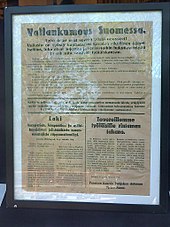People's Commissariat (Finland)
The Finnish People's Commissariat (also called People's Delegation ) was the socialist revolutionary government that was constituted at the beginning of the Finnish Civil War on January 27th and 28th, 1918. According to the Soviet model, the provisional executive body consisted of 12 to 14 delegated People's Commissars , who, like ministers in a bourgeois government, were each responsible for a defined area of responsibility. The delegates were recruited from the most radical organizations and representatives of the Finnish labor movement, under the leadership of the party leader of the Social Democrats (SDP) Kullervo Manner . Was added represents the People's Commissariat as a supervisory and legislative branches of the general workers 'council , which was largely equal representation from the main part in the revolution workers' organizations, in addition to the SDP were the especially the Federation of Trade Unions and the paramilitary Red Guard . However, in the general uproar, the Supreme Workers' Council failed to establish itself as a powerful state organ and remained of little importance to the People's Commissariat.
history
The formation of the revolutionary government was the January 23, the renewed exclamation general strike preceded after the general strike had been canceled in November 1917 after only six days, the workers Executive Committee of 27 January decided to proclaim the revolution. This was followed by the proposal of the committee to form the delegation of people's commissars and the general workers' council .
At the same time as the revolution was declared, operations by the previous military began. In the civil war that had started, the revolutionaries were only able to prevail temporarily in the south and only actually exercise state power there, while the north of the country was ruled by the “whites” . Even if the area of the "Reds" made up only a small part of the national territory, both the historical and the current capital of Finland with Turku and Helsinki and Tampere the most important industrial center were under their control. The People's Commissariat was recognized as the legitimate Finnish government by the Soviet Union alone. Since the military situation of the Red Guards became more and more precarious due to the massive intervention of German troops, most representatives of the "People's Government" avoided Helsinki after Vyborg after the collapse of the Western Front as a result of the heavy defeat in the Battle of Tampere in early April 1918 . In the weeks that followed, leading up to their dissolution on May 1st, the revolutionary organs increasingly lost their influence in the chaos of the last skirmishes of the civil war. Many former People's Commissars were able to escape abroad, especially to the Soviet Union , including Kullervo Manner, who died there as a victim of the Great Terror in 1939 in a Gulag labor camp .
The liberal and democratic constitution drawn up by the People's Commissariat under the leadership of Commissioner for Education Otto Ville Kuusinen was not brought to a referendum as planned.
Supporting documents and comments
- ↑ histdoc.net: The revolutionary government of Finland.
- ↑ a b Toivo J. Paloposki: source study the history of Finland , Wiesbaden 1988
- ↑ The terms “red” and “white” are common terms even in academic publications on the Finnish civil war, which are used like official names.


